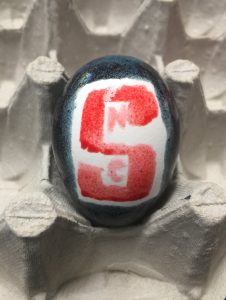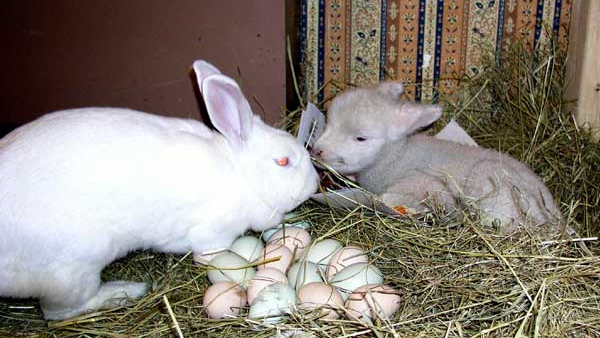Try These at Home: Tips for Egg-cellent Easter Fun

With Easter just around the corner, the peeps in the Prestage Department of Poultry Science (PDPS) want to share their tips for safe, family-friendly Easter fun.
Keep it Safe
First things first, keep it safe this Easter (and all year ’round). Ken Anderson reminds everyone that boiled eggs need to be refrigerated. Whether you’re coloring them or prepping food, eggs like to keep it cool, before and after cooking.
Peeling Made Easy
Ever wondered why some eggs are easier to peel than others? It’s all about time. Newer eggs are harder to peel, so use your older eggs for boiling. How can you tell? Check the carton info:

According to Anderson, the number to notice is the three-digit code in the second line (060). That’s called a Julian number. It refers to the day in the year that the eggs were packed. Online converters can help you find the month and day quickly. In this example, the eggs were packed on March 1, the 60th day of the year.
The rest of the information is helpful, too. The date shown is the suggested “use by” date from the egg company. Anderson says these dates vary and aren’t expiration dates. If you keep your eggs refrigerated, they’ll last 5-6 weeks after packing. P1247 refers to the plant and A3 is the lot number.
Dyed Deviled Eggs

picture by Marissa Herchler
Try something a little bolder at this year’s Easter gatherings: dyed deviled eggs. Marissa Herchler advises dying the eggs after peeling to get the whites “really bright.” If you’re looking for fillings, she recommends Debbie Moose’s Deviled Eggs: 50 Recipes from Simple to Sassy.
Want more recipes? Check out the North Carolina Egg Association’s 2019 Easter Hub.
Family Fun
Watercolor Brush Pens

picture by Becca Wysocky
Becca Wysocky recommends watercolor brush pens for egg coloring: they make it “easier to handle the egg” for kids and (most importantly!) “it’s less messy.” Get creative with white crayon or wax pen to make custom designs.
Bold Dyed Eggs
Love Easter and want bolder colors? Marissa Herchler says add “a ‘ton'” of food coloring with hard boiled eggs until the colors come out “super bright.” The result is so bold, we pictured the eggs at the top of this article.
Squishy Eggs
If you’re looking for something with a science flair, check out Mary Fosnaught’s squishy egg activity. All you need is white vinegar, an egg and time! Be sure to plan ahead – this activity takes a couple of days.
- Put an egg gently in a clear container with lid.
- Label with name, date and time.
- Cover egg with white vinegar.
- Wait 24 hours.
- Pour off vinegar.
- Cover egg with white vinegar.
- Wait at least 24 hours.
- Check egg. (Is it shell-less and squishy yet? If not, let the reaction take a bit longer.)
- Use a flashlight (or your phone!) to peek inside at the egg yolk – the start of the chicken life cycle.
If you’re interested in more kid-friendly science, check out our Poultry 4-H and Youth programs.
Silk Tie Eggs
Chelsey Coleman recommends another way to decorate those eggs. Use old silk ties with boiling vinegar and water to transfer patterns to your eggs. Directions are easy to find online, starting with Martha Stewart’s Silk-Tie Easter Eggs.
Easter Eggers

picture by Marilyn Mayer
Marilyn Mayer highlights Easter Eggers, “a mixed breed of chickens that have the blue egg gene, but don’t fully meet the breed specifications of either Araucanas or Ameraucanas. They can lay blue, green, tan, pink or even yellow eggs!”
We hope these tips get you egg-cited for the holiday weekend. Everyone at PDPS hopes your Easter is egg-cellent, no matter how you plan to spend the day!


